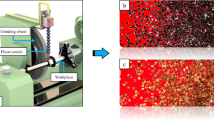Abstract
The selection of the grinding wheel is an important step during the process planning of grinding operations, especially for high-quality small components of hardened steel. The correct choice of the grinding wheel and the proper selection of cutting parameters can provide ground surfaces with high quality and positively affect the economic aspects of the process. The present work compares the performance of seeded-gel and CBN grinding wheels in external cylindrical plunge grinding of 100Cr6 steel in a range of high peripheral speeds, where it is possible to use both grinding wheels. The comparison was made taking into account the workpiece surface roughness and indices like the grinding ratio, specific grinding energy and grinding efficiency. The use of the CBN grinding wheel resulted in lower surface roughness values than those obtained with the seeded-gel grinding wheel. For both grinding wheels, there was a tendency that increasing peripheral speed reduces the surface roughness values. The best performance of the seeded-gel grinding wheel was found at 150 mm3/min/mm, where the grinding efficiency increased with the peripheral speed, and the highest value of all the performed experiments was achieved at 80 m/s. This value was approximately three times the grinding efficiency of the CBN grinding wheel under the same cutting conditions. The highest grinding efficiency for the CBN grinding wheel was achieved at 200 mm3/min/mm and 80 m/s. The grinding efficiency of the seeded-gel wheel dropped for this cutting condition due to higher wheel wear.











Similar content being viewed by others
References
Malkin S, Guo C (2008) Grinding technology: theory and applications of machining with abrasives. Industrial Press, New York
Webster J, Tricard M (2004) Innovations in abrasive products for precision grinding. CIRP Ann 53(2):597–617. https://doi.org/10.1016/S0007-8506(07)60031-6
Nadolny K (2014) State of the art in production, properties and applications of the microcrystalline sintered corundum abrasive grains. Int J Adv Manuf Technol 74:1445–1457. https://doi.org/10.1007/s00170-014-6090-2
Eranki J, Xiao G, Malkin S (1992) Evaluating the performance of “seeded gel” grinding wheels. J Mater Process Technol 32(3):609–625. https://doi.org/10.1016/0924-0136(92)90257-S
Klocke F (2009) Manufacturing process 2 (Grinding honing lapping). Aachen. Springer, Berlin, Heidelberg
Klocke F, Engelhorn R, Mayer J, Weirich T (2002) Microanalysis of the contact zone of tribologically loaded second-phase reinforced Sol-gel-abrasives. CIRP Ann 51(1):245–250. https://doi.org/10.1016/S0007-8506(07)61509-1
Nadolny K (2015) Wear phenomena of grinding wheels with sol-gel alumina abrasive grains and glass–ceramic vitrified bond during internal cylindrical traverse grinding of 100Cr6 steel. Int J Adv Manuf Technol 77(1):83–98. https://doi.org/10.1007/s00170-014-6432-0
Starkov VK, Ryabtsev SA, Polkanov EG, Kiskin OS (2014) Comparative analysis of performance of cubic boron nitride and microcrystalline alumina tools in profile grinding of form cutters. J Superhard Mater 36(1):43–48. https://doi.org/10.3103/S1063457614010079
Nadolny K, Kapłonek W (2016) The effect of wear phenomena of grinding wheels with sol-gel alumina on chip formation during internal cylindrical plunge grinding of 100Cr6 steel. Int J Adv Manuf Technol 87:501–517. https://doi.org/10.1007/s00170-016-8500-0
Selvakumaran D, Arunachalam N, Vijayaraghavan L, Balan ASS (2018) Performance comparison of sol-gel with white alumina abrasives for grinding of super duplex stainless steel (SDSS). Proc Manuf 26:1448–1458. https://doi.org/10.1016/j.promfg.2018.07.098
Uddeholm Tooling (2012) Grinding of tool Steel. Technical brochure. https://www.uddeholm.com/app/uploads/sites/41/2017/12/grinding-eng_t_R121214_e7.pdf. Accessed 15 Apr 2019
Marinescu ID, Hitchiner MP, Uhlmann E, Rowe WB, Inasaki I (2016) Handbook of machining with grinding wheels. Taylor & Francis Group, Boca Raton
Duscha M, Linke B, Klocke F, Dornfeld D (2012) Higher Competitiveness of speed-stroke grinding by using increased wheel speeds. In: Proceedings of the ASME 2012 international manufacturing science and engineering conference Notre Dame, Indiana, USA
Ding W, Dai C, Yu T, Xu J, Fu Y (2017) Grinding performance of textured monolayer CBN wheels: undeformed chip thickness nonuniformity modeling and ground surface topography prediction. Int J Mach Tools Manuf 122:66–80. https://doi.org/10.1016/j.ijmachtools.2017.05.006
Chang L, Jeng Y (2013) Effects of negative skewness of surface roughness on the contact and lubrication of nominally flat metallic surfaces. Proc IMechE Part J Eng Tribol 227(6):559–569. https://doi.org/10.1177/1350650112465365
Kundrak J, Gyani K, Bana V (2008) Roughness of ground and hard-turned surfaces on the basis of 3D parameters. Int J Adv Manuf Technol 38:110–119. https://doi.org/10.1007/s00170-007-1086-9
Sedlaček M, Gregorčič P, Podgornik B (2017) Use of the roughness parameters Ssk and Sku to control friction—a method for designing surface texturing. Tribol Trans 60(2):260–266. https://doi.org/10.1080/10402004.2016.1159358
Chen L, Liu Z, Wang B et al (2019) Surface characterization and tribological performance of anodizing micro-textured aluminium–silicon alloys. Materials 12(11):1862. https://doi.org/10.3390/ma12111862
Zhi G, Li X, Luo A, Yang J, Rong Y (2017) An experimental investigation on response of CBN super abrasive’s grinding performance and failure characteristics to the grinding speed. Exp Tech 41:117–130. https://doi.org/10.1007/s40799-016-0159-9
Jackson MJ (2007) Modelling of fracture wear in vitrified CBN grinding wheels. J Achiev Mater Manuf Eng 24(1):230–236
Wenfeng D, Linke B et al (2017) Review on monolayer CBN superabrasive wheels for grinding metallic materials. Chin J Aeronaut 30(1):109–134. https://doi.org/10.1016/j.cja.2016.07.003
Marinescu ID, Tonshoff HK, Inasaki I (2015) Handbook of ceramic grinding and polishing. William Andrew Publishing, Berkshire
Steffens K, König W (1983) Closed loop simulation of grinding. CIRP Ann 32(1):255–259. https://doi.org/10.1016/S0007-8506(07)63400-3
Upadhyaya RP, Malkin S (2004) Thermal aspects of grinding with electroplated CBN wheels. J Manuf Sci Eng 126(1):107–114. https://doi.org/10.1115/1.1644547
Toenshoff HK, Peters J, Inasaki I, Paul T (1992) Modelling and simulation of grinding processes. CIRP Ann 41(2):677–688. https://doi.org/10.1016/S0007-8506(07)63254-5
Acknowledgements
The authors would like to thank Saint-Gobain Abrasives (Sales and Application Engineering Departments) and Robert Bosch Ltda for supporting this research.
Author information
Authors and Affiliations
Corresponding author
Additional information
Technical Editor: Adriano Fagali de Souza.
Publisher's Note
Springer Nature remains neutral with regard to jurisdictional claims in published maps and institutional affiliations.
Rights and permissions
About this article
Cite this article
de Oliveira Arantes, L., Polli, M.L. Performance comparison of seeded-gel and CBN grinding wheels for cylindrical plunge grinding of 100Cr6 steel. J Braz. Soc. Mech. Sci. Eng. 42, 596 (2020). https://doi.org/10.1007/s40430-020-02686-8
Received:
Accepted:
Published:
DOI: https://doi.org/10.1007/s40430-020-02686-8



